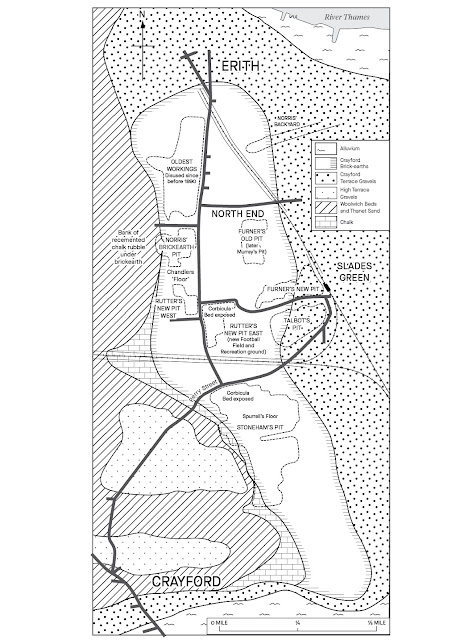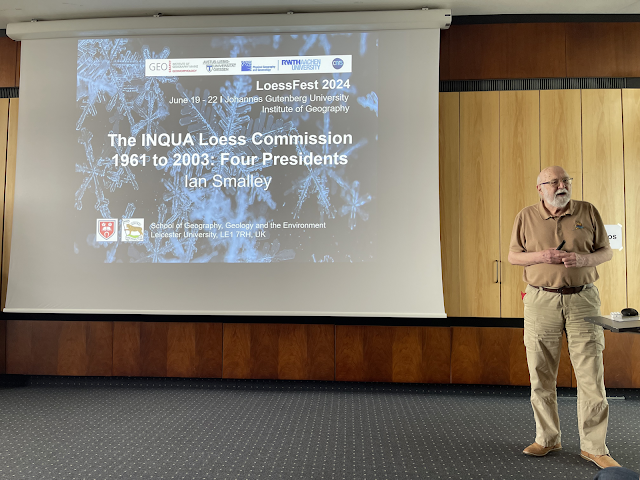V.I.Krokos 1889-1936
Loess Ground
A blog for loess scholars and enthusiasts
Friday, 23 May 2025
Saturday, 1 March 2025
London Stock bricks at Deptford Station, London-Greenwich Railway
Deptford Station was on the London to Greenwich Railway; the first of the London railways (opened 1836-1838). Much of the railway was on a large brick viaduct (of 878 arches) which was built from London Stock bricks obtained from Faversham. These were shipped up the river in barges and unloaded at the Deptford Creek. Much building and rebuilding has occurred since 1838 but some very old bricks are still visible at Deptford Station.
The repointing is fairly modern but these are old stock bricks, classic hand made bricks. The red bricks are much later additions.
Wednesday, 29 January 2025
London Loess: the brickearth deposits at Crayford & Erith
In 1944 Alfred Kennard published, in the Proceedings of the Geologists Association, a sketch map of the Crayford Brickearths region. There is growing interest in the UK loess so it seems like a good idea to publish a slightly updated version of the Kennard map. The revisions were done by Kerry Allen at the University of Leicester Cartographic Unit; a discussion of the new map will be published in British Brick Society Information.
Saturday, 10 August 2024
A blog by Glyn Harries: #41, London's Yellow Stock Brick
https://buildinglondon.blog
no.41: London's Yellow Stock Brick
a blog by Glyn Harries published 12 July 2022
A long, beautifully illustrated blog about London Stock Bricks- and how they are made from Loess. Glyn is very careful to discuss the various suggestions that London Clay was involved in the making of LSB but he comes down on the side of Loess. This blog, no.41, has been republished on the Loess Appreciation Group website.
Marks Tey brick kiln (in Essex) . Marks Tey is one of the few brickfields where we have information about the local brickearth. Grenville Lill in his Leeds U PhD thesis managed to get Marks Tey samples and do some useful thermogravimetric analyses.
Friday, 10 May 2024
Lucas, Brothers- making bricks at Crayford 1864?
The Commission on Childrens Employment investigated the brickyards of Crayford in 1864-1865. A major report was presented to Parliament in 1866. Two Crayford brickyards were reported on: D & C Rutter, and Lucas, Brothers. D & C Rutter were a well known enterprise and traces of their Crayford activities remain. Rutter's pit is marked on the Kennard map of the Crayford brickearths.
Lucas, Brothers presents problems. It is difficult to find traces of their activities in Crayford. Its hard to believe that the Commissioners misplaced the Lucas, Brothers operation but they do not appear in the Crayford section of Kellys Directory of Kent 1862. The 1866 Report of the Commissioners has a substantial section on Lucas,Brothers:
Reports from Commissions v.24
Crayford Messrs Lucas, Brothers. In the summer of 1864 there were 112 persons employed here; one girl and three boys under 13 years old; six girls and eleven boys between 13 and 18; and six females over 18. Mr H.W.Lord reports.
Mr.Nevill (manager?) reports- The children are employed at the stools with the brick moulders, they are frequently the children of the moulder or some other person in the gang but not always so. We have 52(maybe 32 - report indistinct at this point) stools; there are usually seven persons to each; the children are either barrow loaders or pug boys; the pug boy carries the clay in his arms from the pug mill to the moulder; sometimes a man has two small pug boys of ten tears old or so, instead of one older one; one of these two cuts the clay as it comes from the bottom of the pug mill with a kind of flat fork, which they call a 'cackle'; the barrow loader is often a girl . The clay is prepared for the moulder by a 'walk flatter', who stands by the moulders side, and receives the clay from the pug boy; that is often done by women. The bricks weigh 8 lbs each, there are 28 bricks loaded on each barrow before it is wheeled off; the 'pushers-on' (that is those who wheel off) are usually men.
Mr.Lord reports' I went with Mr Nevill to every stool in both the brickfields worked by Messrs Lucas'. So- two brickfields but where and which? And what do we know about Lucas Brothers? A Construction company; founded in 1842, defunct in 1895. Built Albert Hall (1871) Covent Garden Opera House (1858) Charing Cross Station (1864) Cliveden (1851), Charterhouse School, Woolwich Arsenal ? If their brickworks were operating in 1864 it suggests that maybe Craford bricks were used in the construction of Charing Cross Station; not far by barge from Crayford to the Charing Cross site. But why is there no record of their operations at Crayford? D & C Rutter- well recorded- no records of Lucas Brothers.
An explanation of the Lucas Bros anomaly: There was a typographic error in the Commission report and this resulted in the Lucas Bros operation being classified under Crayford rather than Faversham. The Crayford marker in the text was slightly misplaced making Lucas Bros appear in Crayford rather than Faversham; investigations by Mr.J.Howarth of Erith show Lucas Bros listed in the Kellys Directories for 1874 and 1882 and located at Teynham (near Murston, near Sittingbourne, near Faversham). In 1874 near Crayford there were Rutter D & C at Crayford, Furners at Slade Green, Erith, Dawson at Plumstead Common & Wickham Lane, White John Bazley Bros at Swanscombe, Dartford, Greenhithe & Erith.
Thursday, 9 May 2024
Pictures of Leonard Horner
There are not many pictures of Leonard Horner around- he was famous but not particularly famous. He was one of the few people mentioned by name by Karl Marx in 'Das Kapital'- for his work trying to improve conditions of working children in Victorian Britain. His great love was geology, and his best moments were the few years he spent in and around Bonn, in 1831-1833. While the Horner family were in Bonn they were visited by Charles Lyell, who came to see the remarkable geology- and to marry the oldest Horner daughter Mary. Horner & Lyell explored the crater of the Rodderberg, and examined the loess that it contained.
Horner presented a paper on 'The Geology of Bonn' to the Geological Society in London in 1833- it was published in 1836. One of the first papers on loess in English; a useful complement to Lyell's 1834 Edinburgh paper. For more about Horner and loess read Smalley (2020) and/or Smalley & Markovic (2018).
Smalley, I.J. 2020. Leonard Horner in Bonn 1831-1833, finding loess and being incorporated into Lyell's Loess Legion. GeoLogos 26, 163-170.
Smalley, I.J., Markovic, S.B. 2018. An enthusiasm for loess: Leonard Horner in Bonn and Liu Tung-sheng in Beijing. Open Geosciences 10, 925-931.
Loess200*2024
















